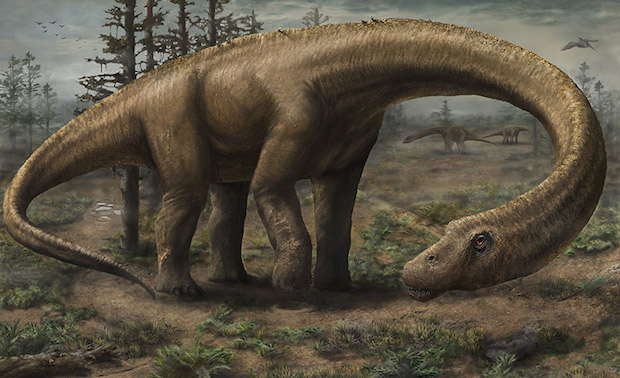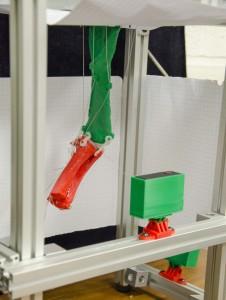In 2005 in a remote area of southern Patagonia in Argentina, a team of researchers from Drexel University found the mostly complete skeletal remains of a 65-ton supermassive dinosaur named Dreadnoughtus Schrani. With more than 70% of its bones remaining intact, it would give research teams access to a wealth of information about the huge species of dinosaur, and provide more research opportunities than they will probably ever be able to use. Given the size of the Dreadnoughtus, the researchers, led by Dr. Kenneth Lacovara, decided to try to use the skeleton to find out exactly how a creature that massive was able to exist on the ground and not collapse under its own weight.
The Drexel researchers decided that the best way to find out how Dreadnoughtus was able to walk on land was to create a smaller-scale 3D printed replica and test it as a real world simulation. After the skeleton was discovered, carefully uncovered over the span of five years, and painstakingly shipped back to Lacovara’s lab in Philadelphia each of the bones was carefully 3D scanned. It took him, his team and about 100 volunteers 600 hours to 3D scan all 145 individual fossilized Dreadnoughtus bones. 3D scanning is proving to be an invaluable tool for paleontology researchers — not only does it allow them to share the files with colleagues all over the world, but it allows them to run complicated tests without having to actually risk damaging the bones.
Once the lengthy 3D scanning process was complete the files were handed over to College of Arts and Sciences doctoral candidate Kristyn Voegele. Her goal was to help determine exactly how these huge beasts moved on land by rebuilding the dinosaur. She decided that she would build a biomechanical computer model of its leg that would allow her to build working replicas that would offer insight into the mechanics of possible movements. Sadly, the bones were buried underground for almost 80 million years, and since the skeleton is only about 70% complete Voegele had to make repairs and fill in the blanks. She edited the 3D models in the popular 3D graphics editing program Maya, and was able to correct the damages done to the bones in just a handful of hours.
With the 3D model complete Voegele could finally get to do the work that she really wanted to do to the virtual skeleton. She used a mechanical simulation software package called MSC Adams to find the most likely places where the ligaments would have attached to the bones. Voegele attached digital 3D models of the suggested musculature onto the bones, and then tested all of the various movements possible. Voegele had a general idea of where to place the tendons and cartilage based on the general shape of the bones, clues from modern reference species and the motion of the joint model to guide her.
Once a good digital approximation of the working dinosaur leg was completed, Voegele handed over the reins to 3D printing expert and undergraduate student David McDevitt who spent ten hours carefully 3D printing 1/10 scale replicas. McDevitt also 3D printed molds of the tendons and muscles so they could be cast in a flexible silicone rubber. When Voegele created the digital models of the bones she added small nubs that would attach to the more flexible ligaments. The leg was assembled and then inserted into a specially designed biomechanical rig equipped with three banks of motors that would simulate the leg’s movement by flexing three different muscle groups simultaneously.
Currently the dinosaur leg model is only capable of pretty basic leg movements, but McDevitt is hoping to add more functionality the more that they learn. Even at the smaller size, watching the 3D printed leg move is similar enough to provide plenty of data that helps the researchers understand what was involved with the Dreadnoughtus walking on land. According to Voegele, the advantage of having a physical model over a virtual one is the natural pull of gravity on the leg and how the specific shape of the bones impacts that natural movement. A simulation could be made, but it would be extremely difficult and time consuming to program into any simulations to account for those two specific forces.
“These two forces were the big factors at play when dinosaurs moved. We suspect that energy efficiency and conservation had a lot to do with their behavior and movement, so being able to study movement from a biomechanical standpoint gives us a great perspective on how these creatures might have move,” Voegele told the Drexel News blog.
When the mechanical dinosaur leg is turned on it typically flexes a few dozen times in a row. Powerful sensors and cameras record the legs movements from three different vantage points. Eventually the captured footage and data will be compared with the digital model of the leg. This will allow them to adjust the basic design to make it more natural, and ultimately perfect the replica leg so it can be used in other experiments.
Below is a video explaining exactly how massive really was. Discuss in the 3D Printed Dinosaur Bones forum over at 3DPB.com.
Subscribe to Our Email Newsletter
Stay up-to-date on all the latest news from the 3D printing industry and receive information and offers from third party vendors.
You May Also Like
3D Printing Unpeeled: New Arkema Material for HP, Saddle and Macro MEMS
A new Arkema material for MJF is said to reduce costs per part by up to 25% and have an 85% reusability ratio. HP 3D HR PA 12 S has been...
3D Printing News Briefs, January 20, 2024: FDM, LPBF, Underwater 3D Printer, Racing, & More
We’re starting off with a process certification in today’s 3D Printing News Briefs, and then moving on to research about solute trapping, laser powder bed fusion, and then moving on...
3D Printing Webinar and Event Roundup: December 3, 2023
We’ve got plenty of events and webinars coming up for you this week! Quickparts is having a Manufacturing Roadshow, America Makes is holding a Member Town Hall, Stratafest makes two...
Formnext 2023 Day Three: Slam Dunk
I’m high—high on trade show. I’ve met numerous new faces and reconnected with old friends, creating an absolutely wonderful atmosphere. The excitement is palpable over several emerging developments. The high...




































